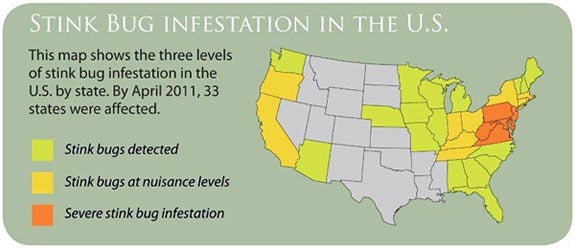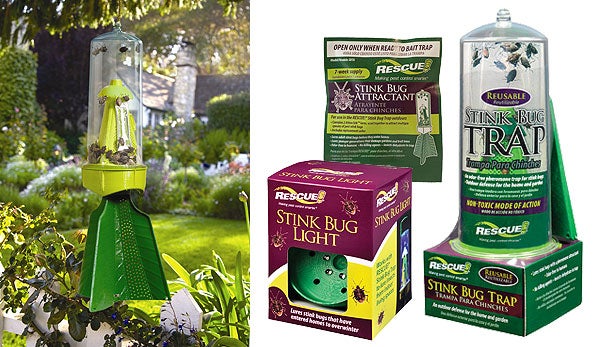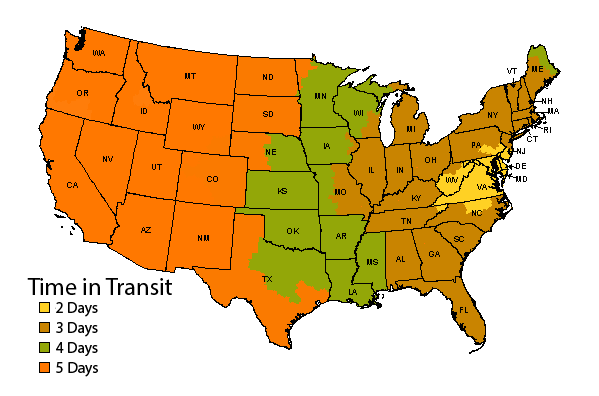
As the temperatures drop, you see them creep indoors – dusty brown insects about the size of a thumbnail, shaped like tiny shields. They’re stink bugs, and the good news is that they don’t bite, sting, or damage your home. The bad news is that they (along with all their relatives) want to spend the winter inside with you, whether you like it or not. But what exactly are these pesky critters?
What Are Stink Bugs?
Native to Japan, Korea, Taiwan and China, Halyomorpha halys first showed up in Pennsylvania around the turn of the millennium. They have now spread to 33 states (see map below).

Sometimes known as “shield bugs” because of their distinctive shape, they’re much more commonly known as “stink bugs.” Their recent emergence in the heartland states (often referred to as “the nation’s breadbox”) is especially troubling, as in this area stink bugs are more than a mere nuisance and pose a serious threat to crops.
Stink Bug Q&A
Do stink bugs really stink?
Yes, stink bugs really do stink. A tiny gland located on their thorax between the first and second pair of legs emits a liquid toxin with the pungent odor (described by some as similar to that of smelly feet) that is their primary defense. This odor acts as a repellent to birds or any other predator that might threaten the stink bugs—including humans.
Stink bugs release their odor when chased, picked up, or stepped on. If you have a lot of them in your house, the smell tends to linger (fortunately it can be eliminated by washing down the surfaces with ordinary soap and water).
Why Are There So Many Stink Bugs Everywhere?
Stink bugs reproduce 4 times a year. Each time a stink bug reproduces, it lays between 20-30 eggs on tree and other plant leaves. Stink bugs undergo metamorphosis in three stages: egg, nymph and adult. The eggs are laid in groups on stems and the undersides of leaves. When nymphs emerge, they look similar to the adult stink bug, but may appear rounder rather than shield-shaped. Nymphs go through five instars before becoming adults, usually in 4-5 weeks. The adult stink bug overwinters under boards, logs or leaf litter. In some species, the nymphs may also overwinter.
With no natural predators in the United States, multiple reproductive cycles, fast development and an ability to travel easily (hitching rides on buses and in construction materials), the numbers of stink bugs have exploded, and they’re spreading fast across the country.
What Makes Stink Bugs Such A Nuisance?
While stink bugs aren’t known for biting, stinging, or carrying diseases, they will gobble up your fruits and veggies – and even your ornamental trees and shrubs. What’s even more annoying to urban dwellers is their propensity for moving in: when the weather gets cold, they seek shelter in detached homes and apartment and office buildings alike, sneaking in through cracks, screenless windows and any other openings they can find by the dozens. And because they’re resistant to most conventional pesticides and small enough to hide almost anywhere, once they’re in, they’re tough to get out.
What Is The “Peak Season” For Stink Bugs?
Because stink bugs won’t reproduce indoors and their food is mostly outdoors, they won’t try to move into until it starts to get cold – usually around late September/early October. The insects sneak in through small cracks and openings in chimneys, door and window frames, air conditioning units, attic vents and holes in a home's foundation. They hide out in toasty, dark spots during the winter, and emerge from hibernation late in the Spring. That’s when you’ll notice them become active again.
What’s The Best Way To Get Rid Of Stink Bugs?
Part of what makes stink bugs so difficult to control is the fact that they are resistant to many types of pesticides. If you find stink bugs on your crops, shake them off into a bucket of soapy water – the soapy water keeps them from flying away. Stink bugs in your house? Vacuuming them up is the best way to vanquish the little beasts, but be sure to use a vacuum with a bag that you can remove, seal up and discard when you’re done. Flushing them down the toilet also works.
Whatever you do, don’t smash them – not only do they smell bad, their distinctive odor attracts others of their kind. In addition to deterring predators, a stink bug’s odor sends a chemical message to other stink bugs, alerting them to danger. The scent glands also play a role in attracting mates, and even suppress attacks by harmful microorganisms. A much better way to scoop up the annoying critters is with our all-natural Stink Bug Chute.
The Stink Bug Trap
Because banishing stink bugs from your house can be so tedious and time-consuming, the best way to get rid of them is to prevent them from entering in the first place. Since they’re attracted to light, don’t leave any unnecessary lights on at night (that’s better for your electric bill and the environment, too). And then there’s the RESCUE Stink Bug Trap:

Made in the USA, the RESCUE! ® Stink Bug Trap is designed to work outdoors, capturing stink bugs before they ruin your garden or get in your home. The reusable trap comes with two, one-week supplies of a pheromone attractant that lures stink bugs in while remaining odor-free to people. Refills are available so you can maintain a stink bug-free environment all season long.
Worried the Stink Bug Trap will attract stink bugs to your yard? Don’t be – it works only to catch those stink bugs within a 20-foot radius, so only the bugs that were already in your yard and garden will be drawn in, trapping them before they damage your garden or invade your home. Nor will the Stink Bug Trap capture those bugs that are beneficial to your garden. Safe and affordable, the Stink Bug Trap is an easier answer to controlling your stink bug problem.
Back to Top







